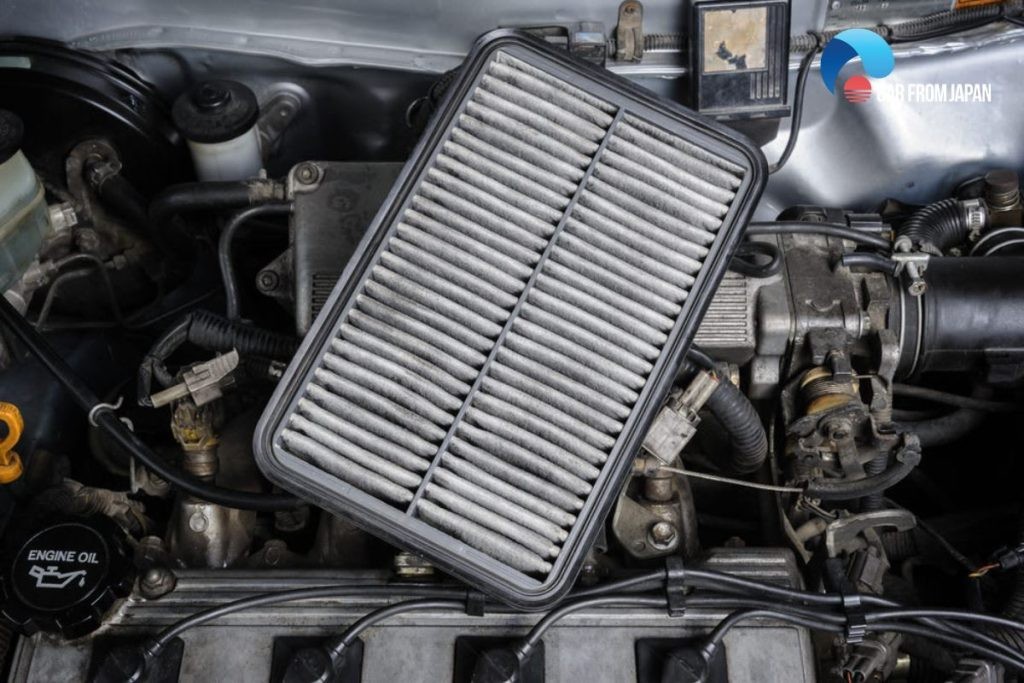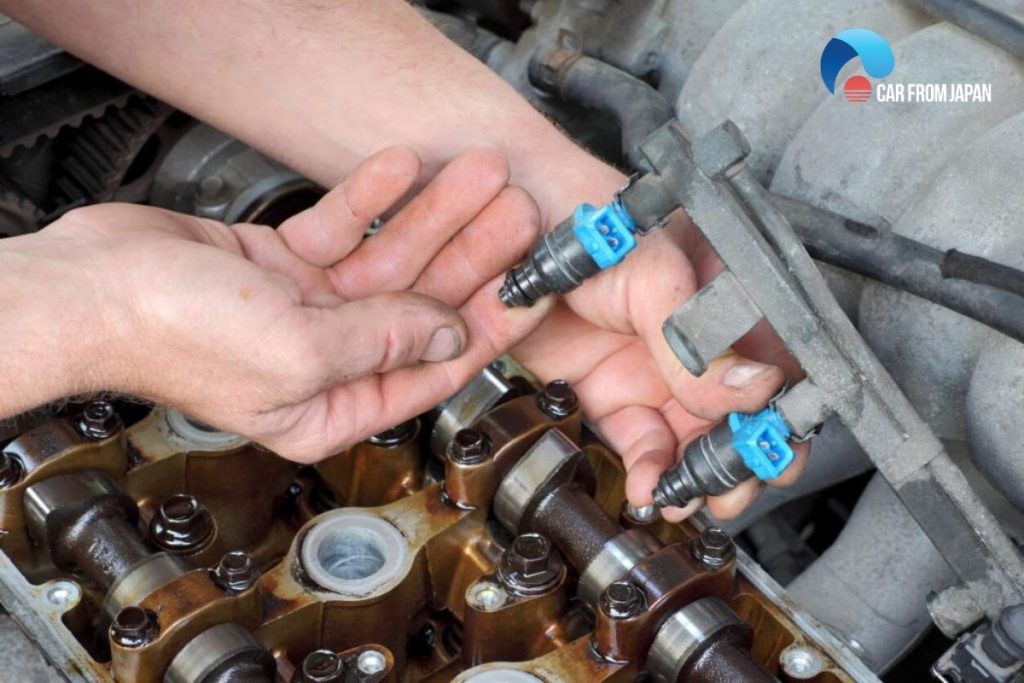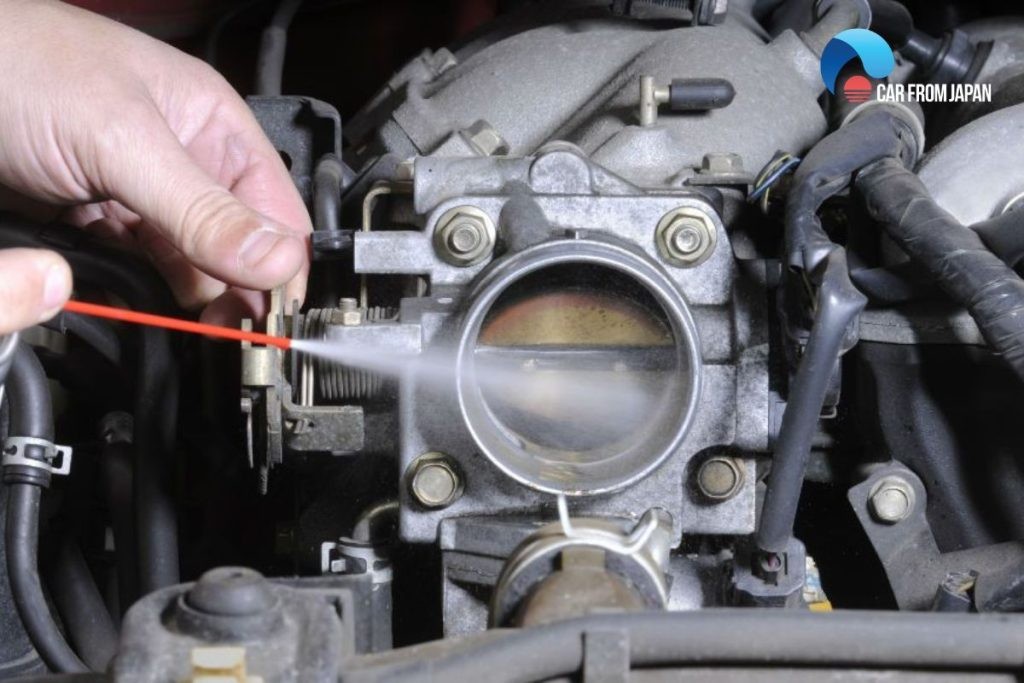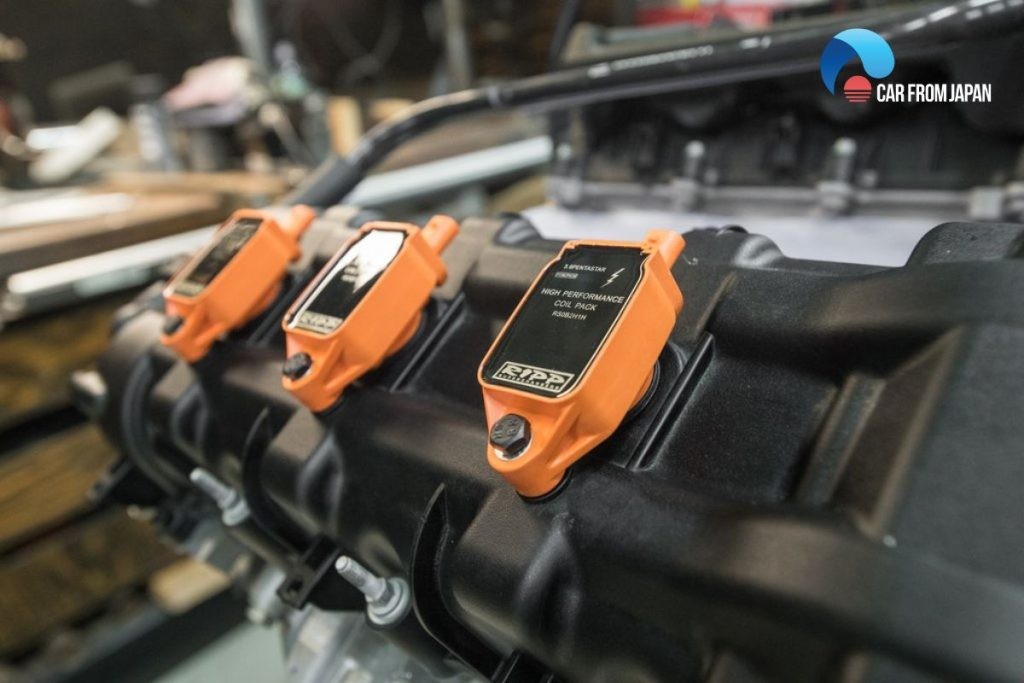Does The Engine Hesitate When Accelerating? It’s a frustrating issue that can stem from various underlying problems. At CAR-TOOL.EDU.VN, we understand how crucial smooth acceleration is for your driving experience and safety. We offer comprehensive guidance and top-quality tools to diagnose and resolve this issue effectively. Find solutions for engine misfires or fuel system malfunctions.
Contents
- 1. Understanding Engine Hesitation During Acceleration
- 1.1. The Combustion Process and Power Generation
- 1.2. Key Components Affecting Engine Performance
- 2. Common Reasons for Car Hesitation When Accelerating From a Stop
- 2.1. Clogged Air Filter
- 2.2. Failing Mass Airflow Sensor (MAF)
- 2.3. Faulty Fuel Pump
- 2.4. Dirty or Clogged Fuel Injectors
- 2.5. Clogged Fuel Filter
- 2.6. Worn-Out Accelerator Pump (Carburetors)
- 2.7. Malfunctioning Throttle Position Sensor (TPS)
- 2.8. Faulty Exhaust Gas Recirculation (EGR) Valve
- 2.9. Failing Ignition Coils
- 2.10. Defective Oxygen Sensors (O2 Sensors)
- 3. Additional Factors Contributing to Hesitation
- 3.1. Transmission Issues
- 3.2. Vacuum Leaks
- 3.3. Catalytic Converter Problems
- 3.4. Electrical Issues
- 4. Step-by-Step Guide to Diagnosing Engine Hesitation
- 4.1. Gather Information
- 4.2. Check the Basics
- 4.3. Use a Diagnostic Scanner
- 4.4. Inspect the Fuel System
- 4.5. Test the Sensors
- 4.6. Check for Vacuum Leaks
- 4.7. Consult a Professional
- 5. Preventive Maintenance to Avoid Engine Hesitation
- 5.1. Regular Oil Changes
- 5.2. Air Filter Replacement
- 5.3. Fuel Filter Replacement
- 5.4. Spark Plug Replacement
- 5.5. Fuel Injector Cleaning
- 5.6. Throttle Body Cleaning
- 5.7. EGR Valve Cleaning
- 5.8. Regular Inspections
- 6. Tools and Equipment for Diagnosing and Repairing Engine Hesitation
- 6.1. Diagnostic Scanner
- 6.2. Multimeter
- 6.3. Fuel Pressure Gauge
- 6.4. Fuel Injector Tester
- 6.5. Vacuum Leak Detector
- 7. Case Studies: Real-World Examples of Diagnosing and Repairing Engine Hesitation
- 7.1. Case Study 1: 2010 Honda Civic with Hesitation During Acceleration
- 7.2. Case Study 2: 2005 Ford F-150 with Hesitation During Acceleration
- 8. FAQs on Engine Hesitation When Accelerating
- 8.1. Why does my car hesitate only after refueling?
- 8.2. Why does my car hesitate when accelerating but not when reversing?
- 8.3. Why does my car hesitate at a green light but then accelerate fine after a few seconds?
- 8.4. Could my key fob battery affect my car’s acceleration?
- 9. Final Thoughts on Resolving Engine Hesitation
1. Understanding Engine Hesitation During Acceleration
Engine hesitation during acceleration, often felt as a delay or stutter when you press the gas pedal, indicates that your engine isn’t receiving the necessary power to increase speed efficiently. According to a study by the University of Michigan’s Transportation Research Institute in 2022, engine hesitation can significantly impact fuel economy and driver safety. This issue is particularly noticeable when accelerating from a stop or driving uphill, requiring a more immediate and substantial power output. The root causes can be diverse, ranging from simple maintenance oversights to more complex mechanical failures.
1.1. The Combustion Process and Power Generation
The engine’s power generation relies on a precise combustion process within its cylinders. This process involves a carefully balanced mixture of air and fuel, ignited by a spark plug. According to research from the Society of Automotive Engineers (SAE), the optimal air-fuel ratio is critical for efficient combustion. Inefficient combustion due to imbalances in this mixture leads to reduced power output. The engine typically has multiple cylinders, each contributing to the overall power output. A disruption in any cylinder can affect the overall performance and cause hesitation.
1.2. Key Components Affecting Engine Performance
Several components play a vital role in regulating the air and fuel supply for combustion. These include:
- Air Filter: Ensures a clean air supply to the engine.
- Mass Airflow Sensor (MAF): Measures the amount of air entering the engine.
- Fuel Pump: Delivers fuel from the tank to the engine.
- Fuel Injectors: Spray fuel into the cylinders for combustion.
- Fuel Filter: Cleans fuel before it reaches the engine.
- Throttle Position Sensor (TPS): Monitors the position of the throttle valve.
- Exhaust Gas Recirculation (EGR) Valve: Recirculates exhaust gases to reduce emissions.
- Ignition Coils: Provide the spark to ignite the air-fuel mixture.
- Oxygen Sensors (O2 Sensors): Monitor exhaust gas composition for optimal fuel metering.
Issues with any of these components can disrupt the combustion process, leading to engine hesitation.
2. Common Reasons for Car Hesitation When Accelerating From a Stop
When your car hesitates when accelerating from a stop, it can be unsettling and potentially dangerous. Addressing this issue promptly is important. Here are 11 common reasons why this might be happening:
2.1. Clogged Air Filter
 Clogged Air Filter
Clogged Air Filter
A clogged air filter restricts airflow to the engine, hindering proper combustion. According to a study by the EPA, a dirty air filter can reduce fuel efficiency by up to 10%.
Symptoms: Reduced acceleration, poor fuel economy, and a possible check engine light.
Solution: Replace the air filter with a new one. This is a simple and inexpensive maintenance task that can significantly improve engine performance. CAR-TOOL.EDU.VN offers a wide selection of high-quality air filters to suit various vehicle models.
2.2. Failing Mass Airflow Sensor (MAF)
The mass airflow sensor measures the amount of air entering the engine and sends this data to the ECU. A faulty MAF sensor can provide incorrect data, leading to an improper air-fuel mixture. Research from Bosch indicates that a malfunctioning MAF sensor can cause the engine to run lean or rich, resulting in poor performance.
Symptoms: Hesitation during acceleration, rough idling, stalling, and a check engine light.
Solution: Clean or replace the MAF sensor. Cleaning can sometimes resolve the issue, but replacement is often necessary for a long-term fix. CAR-TOOL.EDU.VN offers reliable MAF sensors and diagnostic tools to help you identify and resolve this issue.
2.3. Faulty Fuel Pump
A fuel pump delivers fuel from the tank to the engine. A failing fuel pump might not supply enough fuel, leading to hesitation during acceleration. According to a study by the National Highway Traffic Safety Administration (NHTSA), fuel pump failures are a common cause of engine performance issues.
Symptoms: Difficulty starting, stalling, hesitation during acceleration, and a whining noise from the fuel tank.
Solution: Replace the fuel pump. This is a critical component, and a failing fuel pump should be replaced immediately to prevent further damage and ensure reliable performance. CAR-TOOL.EDU.VN provides high-quality fuel pumps that meet or exceed OEM standards.
2.4. Dirty or Clogged Fuel Injectors
 Faulty Fuel Injector
Faulty Fuel Injector
Fuel injectors spray fuel into the cylinders. Over time, they can become clogged with deposits, affecting their ability to deliver fuel efficiently. Research from Chevron indicates that using fuel additives can help keep fuel injectors clean.
Symptoms: Rough idling, hesitation during acceleration, poor fuel economy, and a check engine light.
Solution: Clean or replace the fuel injectors. Fuel injector cleaners can sometimes resolve minor clogs, but professional cleaning or replacement might be necessary for more severe cases. CAR-TOOL.EDU.VN offers fuel injector cleaning kits and replacement injectors to keep your engine running smoothly.
2.5. Clogged Fuel Filter
A fuel filter prevents contaminants from entering the fuel system. A clogged fuel filter restricts fuel flow to the engine, leading to performance issues. According to a study by Fram, replacing the fuel filter regularly can improve engine performance and fuel economy.
Symptoms: Hesitation during acceleration, difficulty starting, stalling, and poor fuel economy.
Solution: Replace the fuel filter. This is a relatively simple and inexpensive maintenance task that can prevent significant engine problems. CAR-TOOL.EDU.VN offers a variety of fuel filters to suit different vehicle makes and models.
2.6. Worn-Out Accelerator Pump (Carburetors)
In older vehicles with carburetors, the accelerator pump provides an extra shot of fuel during acceleration. If the pump is worn out, it may not deliver enough fuel, causing hesitation.
Symptoms: Hesitation during acceleration, particularly when the engine is cold.
Solution: Replace the accelerator pump. This can restore the engine’s responsiveness and improve acceleration. Contact CAR-TOOL.EDU.VN for assistance in finding the right parts for your classic vehicle.
2.7. Malfunctioning Throttle Position Sensor (TPS)
 Throttle Position Sensor
Throttle Position Sensor
The throttle position sensor monitors the position of the throttle valve and sends this data to the ECU. A faulty TPS can provide incorrect data, leading to an improper air-fuel mixture and hesitation during acceleration. Research from Standard Motor Products indicates that a malfunctioning TPS can significantly affect engine performance.
Symptoms: Hesitation during acceleration, rough idling, stalling, and a check engine light.
Solution: Replace the throttle position sensor. This can restore proper engine function and eliminate hesitation. CAR-TOOL.EDU.VN offers reliable TPS sensors and diagnostic tools to help you identify and resolve this issue.
2.8. Faulty Exhaust Gas Recirculation (EGR) Valve
The EGR valve recirculates exhaust gases to reduce emissions. A faulty EGR valve can cause an improper air-fuel mixture, leading to hesitation during acceleration. According to a study by the California Air Resources Board (CARB), a malfunctioning EGR valve can increase emissions and reduce engine performance.
Symptoms: Hesitation during acceleration, rough idling, stalling, and a check engine light.
Solution: Clean or replace the EGR valve. Cleaning can sometimes resolve the issue, but replacement is often necessary for a long-term fix. CAR-TOOL.EDU.VN offers EGR valve cleaning kits and replacement valves to keep your engine running smoothly.
2.9. Failing Ignition Coils
 Failing Ignition Coil
Failing Ignition Coil
Ignition coils provide the spark to ignite the air-fuel mixture. A failing ignition coil can result in a weak spark, leading to misfires and hesitation during acceleration. Research from Delphi indicates that ignition coil failures are a common cause of engine misfires.
Symptoms: Hesitation during acceleration, rough idling, misfires, and a check engine light.
Solution: Replace the failing ignition coil. This can restore proper ignition and eliminate misfires. CAR-TOOL.EDU.VN provides high-quality ignition coils that meet or exceed OEM standards.
2.10. Defective Oxygen Sensors (O2 Sensors)
Oxygen sensors monitor the oxygen content of the exhaust and send this data to the ECU. A defective O2 sensor can provide incorrect data, leading to an improper air-fuel mixture and hesitation during acceleration. According to a study by Denso, a malfunctioning O2 sensor can significantly affect fuel economy and emissions.
Symptoms: Hesitation during acceleration, poor fuel economy, rough idling, and a check engine light.
Solution: Replace the defective oxygen sensor. This can restore proper fuel metering and improve engine performance. CAR-TOOL.EDU.VN offers a variety of O2 sensors to suit different vehicle makes and models.
3. Additional Factors Contributing to Hesitation
Beyond the common causes listed above, several other factors can contribute to engine hesitation during acceleration. Addressing these factors can further improve your vehicle’s performance.
3.1. Transmission Issues
The transmission plays a crucial role in transferring power from the engine to the wheels. Issues such as slipping gears or a malfunctioning torque converter can cause hesitation during acceleration. According to a study by the Automotive Transmission Rebuilders Association (ATRA), regular transmission maintenance can prevent many common transmission problems.
Symptoms: Slipping gears, rough shifting, hesitation during acceleration, and unusual noises from the transmission.
Solution: Consult a qualified mechanic for a transmission inspection and repair. CAR-TOOL.EDU.VN can provide you with the necessary diagnostic tools to assess your transmission’s health.
3.2. Vacuum Leaks
Vacuum leaks can disrupt the air-fuel mixture and cause hesitation during acceleration. These leaks can occur in various locations, such as vacuum hoses, intake manifold gaskets, and throttle body gaskets. Research from Gates indicates that regular inspection and replacement of vacuum hoses can prevent many vacuum leaks.
Symptoms: Rough idling, hesitation during acceleration, poor fuel economy, and a whistling noise from the engine.
Solution: Locate and repair the vacuum leaks. This may involve replacing damaged hoses or gaskets. CAR-TOOL.EDU.VN offers a variety of vacuum hoses and gaskets to help you resolve this issue.
3.3. Catalytic Converter Problems
A clogged or failing catalytic converter can restrict exhaust flow and cause hesitation during acceleration. According to a study by MagnaFlow, a high-flow catalytic converter can improve engine performance and fuel economy.
Symptoms: Hesitation during acceleration, poor fuel economy, a check engine light, and a rotten egg smell from the exhaust.
Solution: Replace the catalytic converter. This can restore proper exhaust flow and improve engine performance. CAR-TOOL.EDU.VN offers a variety of catalytic converters to suit different vehicle makes and models.
3.4. Electrical Issues
Electrical problems, such as faulty wiring or a malfunctioning ECU, can disrupt engine function and cause hesitation during acceleration. Research from the Electrical and Electronics Engineers (IEEE) indicates that proper wiring and grounding are essential for reliable engine performance.
Symptoms: Intermittent hesitation, rough idling, stalling, and a check engine light.
Solution: Consult a qualified mechanic for an electrical system diagnosis and repair. CAR-TOOL.EDU.VN can provide you with the necessary diagnostic tools to assess your vehicle’s electrical system.
4. Step-by-Step Guide to Diagnosing Engine Hesitation
Diagnosing engine hesitation requires a systematic approach to identify the root cause effectively. Here’s a step-by-step guide to help you troubleshoot the issue:
4.1. Gather Information
Begin by gathering as much information as possible about the problem. Note when the hesitation occurs (e.g., during cold starts, acceleration from a stop, or while driving uphill), any accompanying symptoms (e.g., rough idling, stalling, or a check engine light), and any recent maintenance or repairs.
4.2. Check the Basics
Start with the simple and common causes first:
- Air Filter: Inspect the air filter for dirt and debris. Replace it if it’s clogged.
- Fuel Filter: Replace the fuel filter if it hasn’t been changed recently.
- Spark Plugs: Inspect the spark plugs for wear and damage. Replace them if necessary.
4.3. Use a Diagnostic Scanner
Connect a diagnostic scanner to the vehicle’s OBD-II port to check for trouble codes. These codes can provide valuable clues about the source of the problem. Research from Innova indicates that using a diagnostic scanner can significantly reduce diagnostic time.
Common Trouble Codes:
- P0100-P0104: Mass Airflow (MAF) Sensor Circuit Malfunction
- P0171 and P0174: System Too Lean
- P0300-P0304: Random/Multiple Cylinder Misfire Detected
- P0400-P0406: Exhaust Gas Recirculation (EGR) Flow Malfunction
- P0130-P0135: O2 Sensor Circuit Malfunction
CAR-TOOL.EDU.VN offers a variety of diagnostic scanners to suit different needs and budgets.
4.4. Inspect the Fuel System
- Fuel Pump: Check the fuel pump pressure using a fuel pressure gauge. The pressure should be within the manufacturer’s specifications.
- Fuel Injectors: Inspect the fuel injectors for clogs or leaks. You can use a fuel injector tester to assess their performance.
4.5. Test the Sensors
- Mass Airflow Sensor (MAF): Use a multimeter to test the MAF sensor’s output voltage. Compare the readings to the manufacturer’s specifications.
- Throttle Position Sensor (TPS): Use a multimeter to test the TPS’s resistance. The resistance should change smoothly as you move the throttle.
- Oxygen Sensors (O2 Sensors): Use a multimeter or a diagnostic scanner to monitor the O2 sensors’ output voltage. The voltage should fluctuate as the engine runs.
4.6. Check for Vacuum Leaks
Use a smoke machine or a can of carburetor cleaner to check for vacuum leaks. Spray the carburetor cleaner around vacuum hoses, intake manifold gaskets, and throttle body gaskets. If the engine’s idle speed changes, there’s likely a vacuum leak in that area.
4.7. Consult a Professional
If you’re unable to diagnose the problem yourself, consult a qualified mechanic. They have the expertise and equipment to accurately diagnose and repair complex engine problems. CAR-TOOL.EDU.VN can help you find reputable mechanics in your area.
5. Preventive Maintenance to Avoid Engine Hesitation
Preventive maintenance is crucial for avoiding engine hesitation and maintaining optimal performance. Here are some essential maintenance tasks:
5.1. Regular Oil Changes
Change the engine oil and filter according to the manufacturer’s recommendations. Clean oil ensures proper lubrication and reduces wear on engine components. According to a study by Pennzoil, regular oil changes can extend engine life and improve fuel economy.
5.2. Air Filter Replacement
Replace the air filter regularly to ensure proper airflow to the engine. A clean air filter improves engine performance and fuel economy.
5.3. Fuel Filter Replacement
Replace the fuel filter regularly to prevent contaminants from entering the fuel system. A clean fuel filter ensures proper fuel flow to the engine.
5.4. Spark Plug Replacement
Replace the spark plugs according to the manufacturer’s recommendations. New spark plugs ensure proper ignition and combustion.
5.5. Fuel Injector Cleaning
Use a fuel injector cleaner periodically to keep the fuel injectors clean and prevent clogs.
5.6. Throttle Body Cleaning
Clean the throttle body regularly to remove carbon deposits and ensure proper airflow to the engine.
5.7. EGR Valve Cleaning
Clean the EGR valve periodically to remove carbon deposits and ensure proper exhaust gas recirculation.
5.8. Regular Inspections
Perform regular inspections of vacuum hoses, belts, and other engine components to identify and address potential problems before they cause engine hesitation.
6. Tools and Equipment for Diagnosing and Repairing Engine Hesitation
Having the right tools and equipment is essential for diagnosing and repairing engine hesitation. Here are some recommended tools:
6.1. Diagnostic Scanner
A diagnostic scanner is an invaluable tool for retrieving trouble codes and monitoring engine parameters. CAR-TOOL.EDU.VN offers a variety of diagnostic scanners to suit different needs and budgets.
Recommended Diagnostic Scanners:
| Scanner Model | Features | Price Range |
|---|---|---|
| Autel MaxiCOM MK808 | Full system diagnostics, bidirectional control, and special functions | $500 – $700 |
| Launch X431 V+ | Wide vehicle coverage, advanced coding and programming | $1000 – $1500 |
| BlueDriver Bluetooth Pro OBDII Scan Tool | Wireless connectivity, code reading and clearing, live data | $100 – $200 |
6.2. Multimeter
A multimeter is essential for testing sensors, wiring, and other electrical components. CAR-TOOL.EDU.VN offers a variety of multimeters to suit different needs and budgets.
Recommended Multimeters:
| Multimeter Model | Features | Price Range |
|---|---|---|
| Fluke 115 | Accurate readings, durable design | $150 – $200 |
| Klein Tools MM400 | Auto-ranging, easy to use | $50 – $75 |
| INNOVA 3320 | Digital display, multiple functions | $25 – $40 |
6.3. Fuel Pressure Gauge
A fuel pressure gauge is necessary for checking the fuel pump pressure and diagnosing fuel system problems. CAR-TOOL.EDU.VN offers a variety of fuel pressure gauges to suit different needs and budgets.
Recommended Fuel Pressure Gauges:
| Fuel Pressure Gauge Model | Features | Price Range |
|---|---|---|
| OTC 5630 | Wide pressure range, easy to read | $75 – $100 |
| Actron CP7838 | Includes adapters for various vehicles | $50 – $75 |
| Stant 12270 | Basic fuel pressure testing | $25 – $40 |
6.4. Fuel Injector Tester
A fuel injector tester is essential for assessing the performance of fuel injectors and identifying clogs or leaks. CAR-TOOL.EDU.VN offers a variety of fuel injector testers to suit different needs and budgets.
Recommended Fuel Injector Testers:
| Fuel Injector Tester Model | Features | Price Range |
|---|---|---|
| Autool CT150 | Ultrasonic cleaning, multiple test modes | $150 – $200 |
| Launch CNC-602A | Automatic testing, wide injector compatibility | $300 – $400 |
| Mophorn Fuel Injector Tester | Compact, easy to use | $75 – $100 |
6.5. Vacuum Leak Detector
A vacuum leak detector is essential for locating vacuum leaks in the engine. CAR-TOOL.EDU.VN offers a variety of vacuum leak detectors to suit different needs and budgets.
Recommended Vacuum Leak Detectors:
| Vacuum Leak Detector Model | Features | Price Range |
|---|---|---|
| Smoke Machine Automotive EVAP | Professional-grade, easy to use | $200 – $300 |
| Mastercool 56100 | Compact, portable design | $150 – $200 |
| UView 560000 | UV dye and light, effective leak detection | $100 – $150 |
7. Case Studies: Real-World Examples of Diagnosing and Repairing Engine Hesitation
Here are a couple of case studies that illustrate how to diagnose and repair engine hesitation:
7.1. Case Study 1: 2010 Honda Civic with Hesitation During Acceleration
A customer reported that their 2010 Honda Civic was hesitating during acceleration, particularly when driving uphill. The check engine light was on.
Diagnosis:
- Connected a diagnostic scanner and retrieved the trouble code P0171 (System Too Lean).
- Inspected the air filter and found it to be clogged.
- Tested the MAF sensor and found that its output voltage was out of specification.
Solution:
- Replaced the air filter with a new one.
- Replaced the MAF sensor with a new one from CAR-TOOL.EDU.VN.
- Cleared the trouble code.
Result:
The engine hesitation was resolved, and the Honda Civic was running smoothly again.
7.2. Case Study 2: 2005 Ford F-150 with Hesitation During Acceleration
A customer reported that their 2005 Ford F-150 was hesitating during acceleration and had poor fuel economy. The check engine light was on.
Diagnosis:
- Connected a diagnostic scanner and retrieved the trouble code P0302 (Cylinder 2 Misfire Detected).
- Inspected the spark plugs and found that the spark plug in cylinder 2 was worn.
- Tested the ignition coil for cylinder 2 and found that it was not firing properly.
Solution:
- Replaced all spark plugs with new ones.
- Replaced the ignition coil for cylinder 2 with a new one from CAR-TOOL.EDU.VN.
- Cleared the trouble code.
Result:
The engine hesitation was resolved, the fuel economy improved, and the Ford F-150 was running smoothly again.
8. FAQs on Engine Hesitation When Accelerating
8.1. Why does my car hesitate only after refueling?
This could be due to a failing EVAP purge valve, which controls fuel vapors. If it’s stuck open, excess fuel vapors can flood the engine, causing hesitation or rough starts after refueling. According to a study by the EPA, a malfunctioning EVAP system can significantly increase emissions.
8.2. Why does my car hesitate when accelerating but not when reversing?
If hesitation only occurs in drive but not in reverse, it could indicate transmission problems, such as a failing torque converter or solenoid issues affecting forward gears. Research from the Automotive Transmission Rebuilders Association (ATRA) indicates that transmission issues often manifest differently in forward and reverse gears.
8.3. Why does my car hesitate at a green light but then accelerate fine after a few seconds?
This could indicate fuel pressure problems. A weak fuel pump or clogged fuel filter may struggle to deliver fuel instantly but catch up after a moment, reducing hesitation once the car is moving. According to a study by the National Highway Traffic Safety Administration (NHTSA), fuel pressure problems are a common cause of hesitation during acceleration.
8.4. Could my key fob battery affect my car’s acceleration?
Surprisingly, yes, for push-to-start vehicles. A faulty key fob battery can cause delayed communication between the key and the car’s ECU, sometimes leading to temporary throttle hesitation. Research from automotive electronics manufacturers indicates that key fob battery issues can sometimes affect vehicle performance.
9. Final Thoughts on Resolving Engine Hesitation
Addressing engine hesitation is crucial for maintaining your vehicle’s performance, fuel efficiency, and safety. By understanding the common causes, following a systematic diagnostic approach, and performing preventive maintenance, you can effectively resolve this issue and enjoy a smooth and reliable driving experience.
CAR-TOOL.EDU.VN is committed to providing you with the highest quality parts, tools, and information to keep your vehicle running at its best. Visit our website at CAR-TOOL.EDU.VN or contact us at +1 (641) 206-8880 or visit our location at 456 Elm Street, Dallas, TX 75201, United States for expert advice and assistance. Don’t let engine hesitation slow you down; trust CAR-TOOL.EDU.VN to keep you moving forward.
